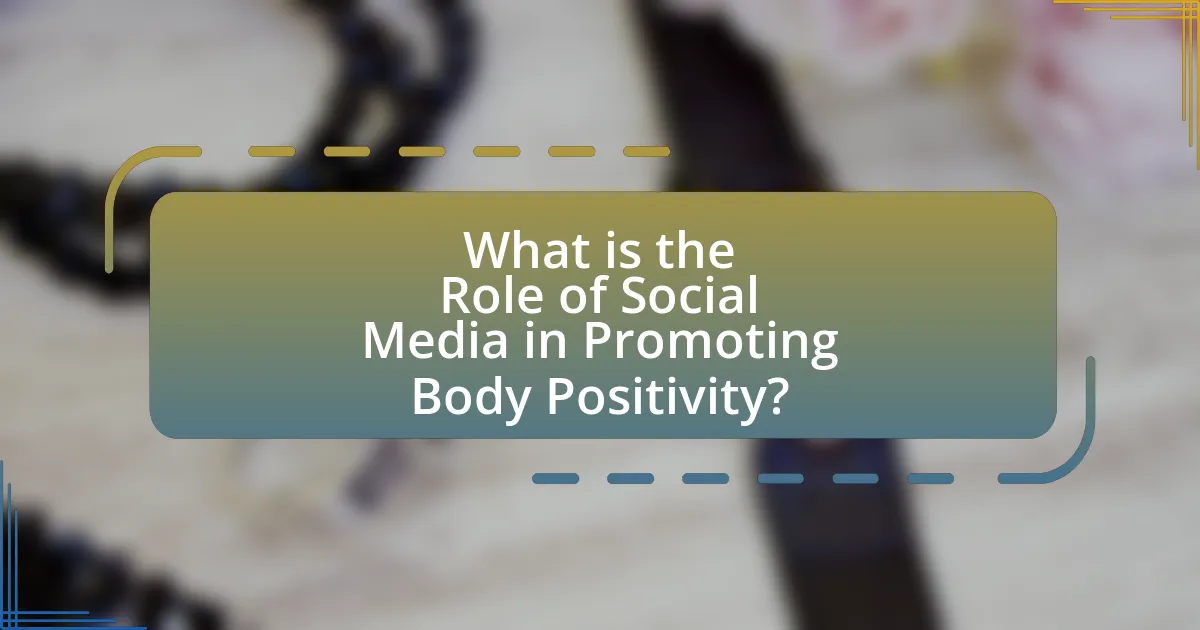The article examines the role of social media in promoting body positivity, highlighting its significance in providing diverse body representations and fostering supportive communities. It discusses how platforms like Instagram, TikTok, and Twitter facilitate body positivity movements through hashtags and community engagement, while also addressing the challenges posed by unrealistic beauty standards and harmful content. Key findings from research indicate that exposure to body-positive content can enhance self-esteem and body image, underscoring the importance of authenticity, inclusivity, and positive messaging in effective body positivity campaigns. The article also explores the impact of social media algorithms, influencer contributions, and the psychological benefits of embracing body positivity in today’s society.

What is the Role of Social Media in Promoting Body Positivity?
Social media plays a crucial role in promoting body positivity by providing a platform for diverse body representations and fostering supportive communities. Through hashtags like #BodyPositivity and #EffYourBeautyStandards, users share personal stories and images that challenge traditional beauty norms, encouraging acceptance of all body types. Research indicates that exposure to body-positive content on social media can improve self-esteem and body image among users, as seen in a study published in the journal “Body Image” by Tiggemann and Slater, which found that participants who engaged with body-positive posts reported higher body satisfaction. Thus, social media serves as a powerful tool for advocacy and change in societal perceptions of body image.
How has social media influenced perceptions of body image?
Social media has significantly influenced perceptions of body image by amplifying both positive and negative ideals. Platforms like Instagram and TikTok often showcase curated images that promote unrealistic beauty standards, leading to increased body dissatisfaction among users; studies indicate that exposure to idealized images correlates with higher rates of eating disorders and low self-esteem. Conversely, social media also serves as a space for body positivity movements, where diverse body types are celebrated, helping to challenge traditional beauty norms and foster acceptance. Research by Perloff (2014) in the journal “Cyberpsychology, Behavior, and Social Networking” highlights that while social media can exacerbate body image issues, it also provides a platform for supportive communities that encourage self-acceptance and promote healthier body image perceptions.
What are the key platforms driving body positivity discussions?
Key platforms driving body positivity discussions include Instagram, TikTok, and Twitter. Instagram facilitates visual storytelling, allowing users to share diverse body images and personal narratives, which has led to the rise of hashtags like #BodyPositivity and #EffYourBeautyStandards. TikTok’s short-form video format encourages creative expression and community engagement, with influencers promoting body acceptance through relatable content. Twitter serves as a space for real-time conversations and activism, where users can share articles, personal experiences, and support movements advocating for body diversity. These platforms collectively foster a culture of inclusivity and challenge traditional beauty standards.
How do social media algorithms affect body image representation?
Social media algorithms significantly influence body image representation by prioritizing content that aligns with user engagement metrics, often favoring idealized and unrealistic body types. These algorithms curate feeds based on likes, shares, and comments, leading to a prevalence of images that conform to societal beauty standards, which can distort users’ perceptions of body image. Research indicates that exposure to such content can contribute to body dissatisfaction and negative self-esteem, particularly among adolescents. A study published in the journal “Body Image” found that individuals who frequently engage with idealized body images on platforms like Instagram report higher levels of body dissatisfaction and lower self-esteem.
Why is body positivity important in today’s society?
Body positivity is important in today’s society because it promotes self-acceptance and challenges societal beauty standards. This movement encourages individuals to embrace their bodies regardless of size, shape, or appearance, fostering mental health and well-being. Research indicates that body positivity can reduce body dissatisfaction and improve self-esteem, which is crucial in a culture often dominated by unrealistic portrayals of beauty in media. For instance, a study published in the journal “Body Image” found that exposure to body-positive content on social media significantly improved participants’ body satisfaction and self-esteem. Thus, body positivity plays a vital role in creating a more inclusive and supportive environment that values diversity in body types.
What psychological benefits does body positivity provide?
Body positivity provides significant psychological benefits, including enhanced self-esteem, reduced anxiety, and improved body image. Research indicates that individuals who embrace body positivity experience a greater sense of self-acceptance, which correlates with lower levels of depression and anxiety. A study published in the journal “Body Image” found that participants who engaged with body-positive content reported higher self-esteem and a more positive body image compared to those who did not. This suggests that body positivity fosters a healthier mental state by encouraging individuals to appreciate their bodies, leading to overall psychological well-being.
How does body positivity challenge societal beauty standards?
Body positivity challenges societal beauty standards by promoting the acceptance of diverse body types and rejecting the narrow definitions of beauty often perpetuated by media and culture. This movement encourages individuals to embrace their bodies regardless of size, shape, or appearance, thereby undermining the traditional ideals that often prioritize thinness and specific physical attributes. Research indicates that social media platforms play a crucial role in this shift, as they provide a space for individuals to share their experiences and celebrate body diversity, leading to increased visibility for non-conforming body types. For instance, a study published in the journal “Body Image” found that exposure to body-positive content on social media can significantly improve body satisfaction among users, demonstrating the impact of these platforms in reshaping perceptions of beauty.
What are the main strategies used on social media to promote body positivity?
The main strategies used on social media to promote body positivity include the use of diverse representation, community building, and positive messaging. Diverse representation involves showcasing individuals of various body types, ethnicities, and abilities, which helps challenge traditional beauty standards and fosters inclusivity. Community building is achieved through the creation of supportive online spaces where users can share their experiences and encourage one another, often facilitated by hashtags like #BodyPositivity and #EffYourBeautyStandards. Positive messaging focuses on affirming self-love and acceptance, often through inspirational quotes, personal stories, and educational content that highlights the importance of mental health and self-esteem. These strategies collectively contribute to a more accepting and supportive online environment, promoting body positivity effectively.
How do influencers contribute to body positivity movements?
Influencers contribute to body positivity movements by promoting diverse body types and challenging societal beauty standards. They utilize their platforms to share authentic representations of themselves, often showcasing unfiltered images and personal stories that resonate with their audiences. Research indicates that 67% of social media users feel more positive about their bodies when they see relatable content from influencers, highlighting the impact of representation. By fostering a community that celebrates individuality and self-acceptance, influencers play a crucial role in shifting perceptions around body image and encouraging followers to embrace their uniqueness.
What role do hashtags play in spreading body positivity messages?
Hashtags play a crucial role in spreading body positivity messages by categorizing content and increasing its visibility on social media platforms. By using specific hashtags like #BodyPositivity or #LoveYourBody, users can connect with a larger community, facilitating the sharing of supportive messages and personal stories. Research indicates that posts with relevant hashtags receive significantly higher engagement rates, which amplifies the reach of body positivity content. For instance, a study published in the Journal of Social Media in Society found that posts with hashtags related to body positivity garnered 30% more likes and shares compared to those without. This increased visibility helps challenge societal beauty standards and fosters a more inclusive dialogue around body image.
How can social media campaigns effectively promote body positivity?
Social media campaigns can effectively promote body positivity by utilizing diverse representation and fostering community engagement. By showcasing individuals of various body types, ethnicities, and abilities, campaigns can challenge societal beauty standards and encourage acceptance. Research indicates that exposure to diverse body images can improve self-esteem and body satisfaction among viewers. For instance, a study published in the journal “Body Image” found that participants who engaged with body-positive content reported higher levels of body appreciation. Additionally, interactive elements such as hashtags, challenges, and user-generated content can create a sense of belonging and support, further amplifying the message of body positivity.
What elements make a body positivity campaign successful?
Successful body positivity campaigns incorporate authenticity, inclusivity, and community engagement. Authenticity ensures that the messages resonate with real experiences, fostering trust among participants. Inclusivity involves representing diverse body types, ethnicities, and gender identities, which broadens the campaign’s appeal and relevance. Community engagement encourages active participation and dialogue, creating a supportive environment where individuals feel empowered to share their stories. Research indicates that campaigns featuring diverse representations and authentic narratives lead to higher engagement rates and positive social impact, as seen in initiatives like the #EffYourBeautyStandards movement, which emphasizes real body representation and has garnered significant online support.
How can brands align with body positivity initiatives on social media?
Brands can align with body positivity initiatives on social media by promoting diverse body types and inclusive messaging in their marketing campaigns. This approach not only reflects the growing demand for representation but also resonates with consumers who value authenticity and inclusivity. Research indicates that 67% of consumers are more likely to purchase from brands that promote body positivity, highlighting the effectiveness of such strategies in driving engagement and sales. By collaborating with body-positive influencers and showcasing real customers in their content, brands can further enhance their commitment to this movement, fostering a community that celebrates all body types.
What challenges does social media face in promoting body positivity?
Social media faces significant challenges in promoting body positivity, primarily due to the prevalence of unrealistic beauty standards and harmful content. These platforms often amplify images and messages that glorify thinness and specific body types, leading to negative self-image among users. Research indicates that exposure to idealized body images on social media correlates with increased body dissatisfaction and eating disorders, as highlighted in a study published in the journal “Body Image” by Perloff (2014). Additionally, algorithms prioritize engagement over well-being, often promoting content that reinforces negative stereotypes rather than diverse representations of body types. This creates an environment where body positivity messages struggle to gain visibility and impact.
How do negative comments and trolling impact body positivity efforts?
Negative comments and trolling significantly undermine body positivity efforts by perpetuating harmful stereotypes and fostering a culture of shame. These negative interactions can lead to decreased self-esteem and increased body dissatisfaction among individuals, particularly those who are already vulnerable. Research indicates that exposure to online harassment can exacerbate mental health issues, with a study published in the journal “Body Image” showing that individuals who encounter negative comments about their appearance are more likely to experience anxiety and depression. This detrimental impact not only affects individual well-being but also stifles community support for body positivity movements, as individuals may feel discouraged from sharing their experiences or engaging in discussions that promote acceptance and diversity in body types.
What are the limitations of social media in fostering genuine body positivity?
Social media has significant limitations in fostering genuine body positivity, primarily due to the prevalence of unrealistic beauty standards and the promotion of edited images. These platforms often showcase idealized body types that do not reflect reality, leading to negative self-image among users. Research indicates that exposure to such content can increase body dissatisfaction and contribute to mental health issues, as highlighted in a study published in the journal “Body Image” by Tiggemann and Slater (2014), which found that social media use correlates with increased body dissatisfaction among adolescents. Additionally, the algorithms used by social media platforms tend to prioritize content that garners more engagement, often favoring posts that conform to traditional beauty norms over those promoting diverse body types. This creates an echo chamber that undermines the authenticity of body positivity movements, limiting their reach and effectiveness.
What practical tips can individuals use to promote body positivity on social media?
Individuals can promote body positivity on social media by sharing authentic and diverse representations of bodies. This includes posting unfiltered images that celebrate different body types, which can help challenge societal beauty standards. Research indicates that exposure to diverse body types can improve body image and self-acceptance among viewers. Additionally, individuals can engage in positive conversations by using hashtags like #BodyPositivity and #LoveYourself, which foster community support and awareness. By actively commenting on and sharing content that uplifts others, individuals contribute to a more inclusive online environment that values all bodies.
How can users create a positive online environment for body image discussions?
Users can create a positive online environment for body image discussions by promoting inclusivity and empathy in their interactions. Encouraging respectful dialogue, sharing diverse body representations, and actively challenging negative comments or stereotypes fosters a supportive atmosphere. Research indicates that supportive online communities can significantly improve individuals’ body image and self-esteem, as seen in studies like “The Impact of Social Media on Body Image” by Perloff (2014), which highlights the importance of positive reinforcement in online spaces.
What actions can individuals take to support body positivity influencers?
Individuals can support body positivity influencers by actively engaging with their content through likes, shares, and comments. This engagement increases visibility and encourages the influencer to continue promoting body positivity. Additionally, individuals can amplify the message by sharing their own experiences related to body positivity, which fosters a supportive community. Supporting brands that align with body positivity values also contributes to the movement, as it encourages more companies to adopt inclusive practices. Research indicates that social media engagement can significantly impact the reach and effectiveness of body positivity campaigns, highlighting the importance of individual actions in this context.














